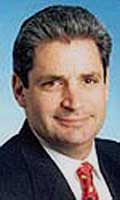By Mark Zdechlik
Minnesota Public Radio
January 23, 2002
The St. Paul Companies Wednesday reported a fourth quarter net loss of $736 million, pushing losses for all of 2001 beyond $1 billion. The nation's fifth-largest business insurer says it has higher hopes for 2002. A new CEO, brought in as part of a major restructing, says he's trying to make The St. Paul leaner and more focused on profit.
| |
|
|
|
||
The St. Paul Companies' nearly $1.1 billion 2001 loss can best be explained by breaking it down into three components that combined to devastate the insurance company's bottom line. Profit from increasing business premiums amounted to nowhere near enough money to offset colossal losses.
The World Trade Center terrorist attacks cost more than $940 million. Medical malpractice division losses, and the decision to get out of that business, cost another roughly $900 million. Finally, under-performing investments ended up costing about $500 million.
The St. Paul ended the year much differently than it started 2001. Newly-named CEO Jay Fishman, who took over in October, has been aggressively cutting costs and reorganizing.
The company is in the process of parting with 1,100 of the 10,000 employees it started 2001 with. Under Fishman's leadership, the St. Paul is zeroing in on its core commercial insurance businesses, instead of speciality products such as medical malpractice insurance.
Fisman has directed the company to forego unprofitable underwriting and the volume it brings, in favor of identifying the highest quality customers. He spoke about his plans during a telephone conference call with insurance industry analysts.
"It is better to earn more money on lower revenues than less money on more revenues," Fishman said. "It is, of course, better to earn more money on more revenues. But if the choice is between volume and profitability, we will opt for profitability. We believe that...creates shareholder value, and that is our job."
Fishman says his cost-cutting and restructuring efforts are progressing according to plan - and in some cases proceeding ahead of schedule. He says the St. Paul is already in the process of cancelling 80 percent of its medical malpractice policies. And he says cuts to corporate overhead will save $50 million this year.
Chief Financial Officer Tom Bradley says the internal changes are happening against the backdrop of substantial premium increases in the non-specialty business insurance market the St. Paul has chosen to focus on.
"We do believe that the core business we do have is a very good business and the market that we're in right now has the ability to perform very well," Bradley says.
During the fourth quarter, Bradley says premiums in the St. Paul's core business areas increased by nearly 20 percent.
Restructuring of such a large scale, coupled with the massive losses the insurance company suffered last year, could easily leave investors skeptical about the future. But insurance industry analyst Paul Newsome of Lehman Brothers says having Fishman at the helm inspires confidence.
Fishman came to the St. Paul from Traveler's Insurance and its parent company, Citigroup. Newsome says while there, Fishman earned a reputation for focusing on the bottom line and cutting out everything in the way.
"Mr. Fishman has an excellent track record at Traveler's with restructuring companies, to allow those companies to return a much higher rate of return on their capital," says Newsome. "They do that through being very disciplined on their underwriting, and cutting lots and lots of costs."
Although Newsome says the St. Paul's restructuring makes sense, he says the business insurance industry has repeatedly caved in on pledges to avoid unprofitable underwriting.
He says premium increases now reflect the industry's realization that it could not be profitable without charging more for coverage. The problem now, according to Newsome, is that while the pricing trend better reflects the actual cost of providing coverage, it has yet to adequately factor in the new threat of terrorism.
More from MPRMore Information

